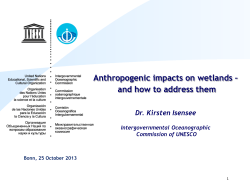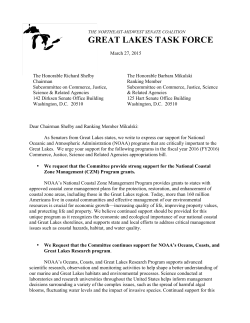
March 24, 2015 The Honorable John Culberson
March 24, 2015 The Honorable John Culberson Chairman Appropriations Subcommittee on Commerce, Justice, Science, and Related Agencies H-310 Capitol Building Washington, D.C. 20515 The Honorable Chaka Fattah Ranking Member Appropriations Subcommittee on Commerce, Justice, Science, and Related Agencies 1016 Longworth House Office Building Washington, D.C. 20515 Dear Chairman Culberson and Ranking Member Fattah: As supporters, stakeholders, employees, and partners of the National Oceanic and Atmospheric Administration (NOAA), Friends of NOAA strongly supports funding the agency at no less than $6 billion in FY16. NOAA is essential to America’s economy, security, environment, and quality of life, and only a balanced approach to funding the agency will allow NOAA to realize the greatest economic and job creation benefits for the American people. With over half of Americans living along our coasts, insured value of coastal property now exceeds $10 trillion, and weather- and climate- sensitive industries accounting for an overwhelming majority of U.S. GDP, Americans need NOAA’s fully integrated range of oceanic and atmospheric data, products, and services now more than ever before. Investing in NOAA strengthens our nation’s capacity for science-based innovation, providing superior economic value by enabling businesses and government to better manage risk and optimize decision-making. If NOAA is to satisfy growing demands for its information and services, Congress must maintain adequate support to sustain states and coastal communities dependent on NOAA’s effective ocean, coastal and fisheries programs while also providing sufficient funding for weather forecasts, warnings and satellites that ensure the nation is prepared for future hazards and disasters. The agency’s science, service, and stewardship missions are interdependent and connected in many ways, and it is critical that adequate funding be provided for NOAA to perform research to advance mission-driven ocean and atmospheric science, collect and distribute data, and to validate and translate that data into products and services that Americans value. NOAA’s ocean and coastal education programs take advantage of the agency’s interrelated missions to provide unique education opportunities and Friends of NOAA believes that these programs are an appropriate and vital component to fulfilling the agency’s missions. We strongly support continued funding of these programs within the agency. It is also imperative that NOAA receives adequate funding to continue to improve its corporate services as a well-managed, efficiently administrated agency that fulfills its missions in today’s complex and changing world. NOAA’s capabilities to observe, understand, predict, and manage risk are absolutely essential to the safe conduct of daily life and the basic functioning of a modern economy. In recent years, numerous communities across the nation have experienced the devastating impacts from weather and climate-related events and fisheries disasters. In 2014 alone, there were eight extreme weather and climate disaster events that each caused more than $1 billion in damage. While we strongly support continued investments in satellite programs that protect American lives and livelihoods, Friends of NOAA strongly urges Congress to develop a stable, long-term vision for funding both satellite procurement and day-to-day operations across the entire agency. The multiple challenges facing the nation underscore the need for overall greater funding for the agency. We applaud NOAA’s proactive leadership in advancing new initiatives to address these challenges and we redouble our support for established, successful core programs. Only a balanced approach to funding across atmospheric and oceanic, existing and new programs will enable NOAA to continue delivering products that minimize loss of life and property damage, give businesses the information they need to create and maintain jobs, enable sound ocean resource management, and enhance capacities to understand and predict Earth’s continually-evolving environment. A strong and balanced budget for NOAA also serves key priorities of Congress relating to creating jobs, addressing climate change, and improving ocean governance. Investments in the following six areas are critical for NOAA to provide maximum benefits to the American people. National Weather Service Forecasts and Warnings: The impacts of severe weather in the U.S. are increasing due to demographic changes, such as increasing population density on our coasts and urban sprawl. Conversion of rural land to suburban landscapes has increased the likelihood that tornadoes will impact a densely populated area. Sufficient funding of the National Weather Service aids in the implementation of its “Weather Ready Nation” campaign and the National Water Center, which build community resilience in the face of growing vulnerability to extreme weather events by increasing lead times of severe weather warnings, improving how forecasts and warnings are communicated to the public and providing new “decision support services” to state and local emergency managers when severe weather is anticipated. Environmental Data to Manage Risk: Long-term environmental information affecting agriculture, marine and freshwater resources, maritime trade and commerce, flooding, forest management, coastal development, and wildland fires give stakeholders critical tools to manage natural resources, ensure safe and efficient navigation, reduce hazard risks, and limit federal liabilities. Drought forecasts are worth up to $8 billion per year to the farming, transportation, tourism, and energy sectors, and a changing ocean affects coastal properties worth $170 billion. Balanced investment is needed to support high quality jobs and research capabilities through the development of new technologies and industries enabled by regional, university and industry partnerships for long-term observations and monitoring of environmental change and to communicate those changes to stakeholders. 2 Healthy Oceans and Coasts: In FY16 we strongly support the trend begun in NOAA’s FY15 budget proposal to adequately fund these critical accounts. For example, we ask you to improve our capability to understand the dramatic impacts already being felt from ocean acidification, to support regional resilience and cooperation, and to strengthen place-based approaches to stewardship of ocean, coastal and Great Lakes resources, such as national marine sanctuaries. Over 2.8 million jobs in coastal construction, fisheries, transportation, recreation, and other ocean-dependent industries rely on healthy ecosystems and contribute more than $282 billion annually to the nation’s GDP. A healthy ocean has drawn nearly half of all Americans to live on the coasts – 51 million workers in coastal counties contribute nearly $6.6 trillion annually to GDP. Balanced investment is needed to support NOAA’s ability to better understand ocean chemistry, provide oceanographic data enabling safe maritime commerce, ensure clean beaches, promote sustainable fishing, encourage place-based stewardship, and strengthen blue economies in thousands of coastal communities. Fisheries Management: Fishery stock assessments and data collection are essential to give managers the information they need to sustain fishing opportunities and jobs while preventing overfishing. Rebuilding all overfished stocks and harvesting them at maximum sustainable yield would generate $31 billion in sales impacts and support up to 500,000 jobs. Balanced investment is needed to build upon recent gains in stock assessments and support the implementation of science-based catch limits that will maintain productive fisheries, secure fishing opportunities and jobs for present and future generations, and support the economic viability of coastal communities. Geostationary and Polar Satellite Systems: Government at all levels, citizens, industry, and the military rely on NOAA satellites producing continuous data for weather forecasting, storm tracking, and long-term observations and monitoring that protect lives and infrastructure. Polar-orbiting and geostationary satellite observations can save up to $1.6 billion per year through better storm warnings, resulting in savings for the maritime commerce, energy, aviation, boating, and agriculture sectors. Stable funding for the operational satellite programs is important for acquisition efficiency and minimizes total cost to taxpayers, while preventing the continued erosion of funding for other core NOAA programs. Unstable funding may also delay launch dates, leaving Americans without the detailed severe weather information and warnings on which they rely every day. Research and Innovation: Cutting-edge science enables the development of innovative technologies, models, and observing systems that improve NOAA’s long-term effectiveness and provide information critical to the basic functioning of a modern economy and safe society. The recent American Academy of Arts and Sciences “Restoring the Foundation” report highlights the declines in federal investment in research and development, and calls for the restoration of our nation’s science enterprise.1 1 Restoring the Foundation: The Vital Role of Research in Preserving the American Dream, American Academy of Arts and Sciences, September 16, 2014, https://www.amacad.org/restoringthefoundation. 3 Research establishes a credible foundation for businesses, government, and other decision makers to understand, predict, and manage the risks of routine and severe weather, changing ocean ecosystems, and other environmental challenges as well as spark innovation and provide opportunities that can shape our nation’s future. This requires the comprehensive modernization of all NOAA’s observation and monitoring operational system, including its oceanographic fleet of vessels, fleet of aircraft, suite of in-situ ocean and coastal sensors, and remote sensing capabilities. Investments in research and innovation results in improvements in ecosystem and environmental observations, forecasting and modeling capabilities; integrated observing systems and the provision of basic environmental data; and the development of tools that help communities plan for extreme weather and other disasters and the nation to make wise investments to ensure lasting economic and national security. We again urge Congress to fund programs essential to protecting lives and livelihoods, such as satellites and weather capabilities, without reducing funding of effective ocean, coastal, and fisheries programs. Furthermore, we strongly encourage you to recognize the unique economic and job creation benefits of NOAA and its partners by funding the agency at no less than $6 billion in FY16. If Friends of NOAA can be of service or provide additional information, please contact Shannon Yee at Shannon@NMSFocean.org or (301) 608-3040. Thank you for your consideration of this request. Sincerely, 4 AccuWeather, Inc. • Alliance for Earth Observations • American Association of Port Authorities American Geophysical Union • American Geosciences Institute • American Rivers American Weather and Climate Industry Association Association for the Sciences of Limnology and Oceanography • Association of National Estuary Programs Association of Public and Land-grant Universities • Association of Zoos & Aquariums Ball Aerospace & Technologies Corp. • Battelle • Campaign for Environmental Literacy The Campbell Marketing Group, Inc. • City of Port Washington, W.I. • Coastal States Organization Colorado Ocean Coalition • The Consortium for Ocean Leadership Department of Fisheries Biology, Humboldt State University • Fugro Pelagos, Inc. • Georgia Conservancy Global Science & Technology, Inc. • Guanaja Mangrove Restoration • Hubbs-SeaWorld Research Institute I. M. Systems Group, Inc. • Institute for Exploration • Integrated Systems Solutions, Inc. International Fund for Animal Welfare • International SeaKeepers Society • IOOS Association The JASON Project •Joint Ocean Commission Initiative Lamont-Doherty Earth Observatory, Columbia University Earth Institute Marine Conservation Institute • Marine Fish Conservation Network • The Mariners’ Museum The Maritime Alliance • Meridian Institute • The National Aquarium National Council of Industrial Meteorologists • National Estuarine Research Reserve Association National Federation of Regional Associations for Coastal and Ocean Observing National Marine Sanctuary Foundation • National Weather Service Employees Organization Natural Resources Defense Council • The Nature Conservancy • Navocean, Inc. • Oceana Ocean Conservancy • Ocean Conservation Research• Ocean Exploration Trust • The Ocean Foundation The Ocean Project • Ogeechee Riverkeeper • Oregon State University • Quantum Spatial • Raytheon Reinsurance Association of America • Restore America’s Estuaries School of Ocean and Earth Science and Technology, University of Hawai`i Scripps Institution of Oceanography • Sea Stewards • SeaWeb • Shipbuilders Council of America Ships of Exploration and Discovery Research, Inc. • UC Davis Bodega Marine Laboratory UCLA Institute of the Environment and Sustainability • United Fishermen's Marketing Association, Inc. University Corporation for Atmospheric Research • University of Colorado, Boulder University of Maryland • University of Miami, Rosenstiel School of Marine and Atmospheric Science The University of Oklahoma • University of South Florida • The University of Washington • Vaisala, Inc. WeatherBank, Incorporated • The Weather Coalition • West Marine • Wisconsin Maritime Museum Woods Hole Oceanographic Institution • World Wildlife Fund
© Copyright 2025









